The 5th
LaureateSculpture
Max Bill
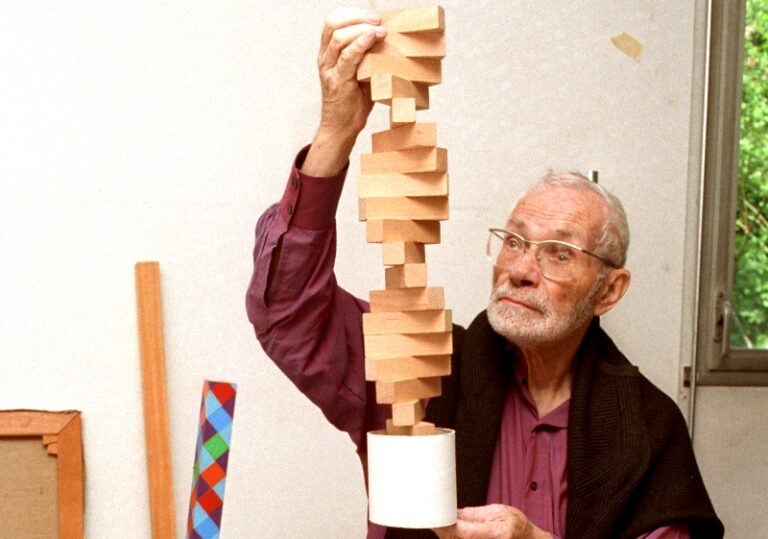
Max Bill graduated from the Bauhaus to be an architect in 1929,but quickly became a renowned designer of geometric-formalist posters and graphics. He became the leading Swiss theorist and exponent of concrete art in the 1930s,basing his entire output on clarity,logic and the belief that art’s purpose was ‘to create a kind of non-changeable,elementary truth.’ He became architect and director of the design school at Ulm in the 1950s; there he promoted an interdisciplinary approach to creation which encompassed all the plastic arts under the heading of visual communication. The building in which Ulm was housed was itself a triumph of rationalist architecture – Bill was anti-monument and rejected the rhetoric of power employed by so much institutional building. Across all media,Bill’s work is the definitive example of rationalism and modernity.
Biography
Max Bill was closely involved with two of the twentieth century’s great centres of visual communication: first as an architecture student at the Bauhaus,and then,after the Second World War,as a founder of the Hochschule für Gestaltung at Ulm in Germany. In 1927,Bill was among the first students to live and work in the new Bauhaus Dessau building designed by Walter Gropius. As well as being exposed to the multidisciplinary teaching of Moholy-Nagy and Josef Albers,he came into contact with Kandinsky,Klee and the founder of the highly influential De Stijl movement,Theo van Doesburg. Painter,poet,polemicist,publisher and keeper of at least two alter egos,van Doesburg’s theories of elementarism and art concret – a rational,artificial expression free from the influence of nature – would provide a foundation for Bill’s future work.
After the Bauhaus,Bill returned to Zurich in 1929 intending to practise architecture. Instead he became known almost immediately as a graphic designer,celebrated for his geometric-formalist posters,such as that for the 1931 ‘Negerkunst’ (Negro Art) exhibition in Zurich,as well as for classic pieces of advertising and information graphics. His design for the Swiss pavilion at the 1936 Milan Triennale created a radically austere setting for the new directions in industrial and graphic design that would later crystallise into the ‘Swiss style’ of the 1950s and 1960s.
During the 1930s Bill became the leading exponent and theorist of concrete art,defining an aesthetic expression which reflected the purely constructed truths of mathematics. At the Milan Triennale he exhibited a ‘concrete’ sculpture which prefigured many of his later works: a realisation of the single-sided geometrical figure known as the Möbius strip. For the next 30 years Zurich was the international centre of concrete art,with exhibitions,publications and activities orchestrated by its chief protagonists Bill and Richard P Lohse. In a 1961 essay,Bill identified his mathematical approach to art as ‘primarily a use of processes of logical thought towards the plastic expression of rhythms and relationships.’ Later he wrote: ‘it is the scope of art to create a kind of non-changeable,elementary truth.’
Bill saw his artworks as Design,as ‘functional objects for spiritual use’. The manifestation of this approach was a series of sculptures for public situations,including his masterpiece,the unrealised competition proposal for a Monument to the Unknown Political Prisoner of 1952. Bill’s primary consideration was the relationship of the viewer to the work: in contrast to almost all monumental sculpture,its architectonic structure was specifically designed to be penetrated and directly experienced by the viewer. In its interactivity and unadorned formalism this work is a kind of anti-monument – unintimidating,calm and quietly expressive; opposed in size as well as situation to the fine art fetishism of individual pieces on a domestic scale.
The totality of Bill’s work cannot be understood through the conventional typologies of painting or sculpture alone. Certainly the vision of an integrated research into communications which had powered the Bauhaus found a new postwar realisation in the Hochschule für Gestaltung in Ulm,which opened in 1951. Bill was instrumental,along with the designer Otl Aicher and Inge Aicher-Scholl,in Ulm’s foundation; he designed the campus and was its first director. Although neither Ulm nor the Bauhaus lasted much more than a decade (and Bill’s involvement with Ulm ended in 1957),the influence of each can still be felt in art and design schools around the world.
The architecture of Ulm,with its brutalist finish and low-rise rationalist aesthetic,was also anti-monumental and freed from the rhetoric of power embodied by much institutional building throughout history. The British architect-theorists Alison and Peter Smithson referred to Ulm’s ‘ordinariness that has a kind of understated lyricism which is full of potential’. The Ulm campus,the Villiger House of 1942–43,and particularly the pavilion he designed for the Swiss Expo 64 in Lausanne,reflect the unity of expression of Bill’s creative programme,in the sense that they are clearly related in conception and execution to the ideas and forms he expressed in graphic and industrial design,in sculpture and in painting. As the viewer walks through it,Bill’s sculpture becomes architecture; at the other end of the scale he called his jewellery designs ‘miniature sculptures’.
In its asceticism and lucid expression of the pure artifice of mathematics,Bill’s work from the 1930s onwards expressed a philosophy which later engendered certain developments in minimal and conceptual sculpture as well as constructive art,and clearly influenced today’s minimalist architects such as the Swiss partnership of Herzog & de Meuron. Yet the true culmination of Bill’s modern,rationalist ethos is not located specifically in either sculpture,painting,architecture or pedagogy,but rather in the synthesis of the plastic arts under the analytical gaze of visual communication.
Mark Thomson
He passed away on December 9,1994,Berlin
Chronology
-
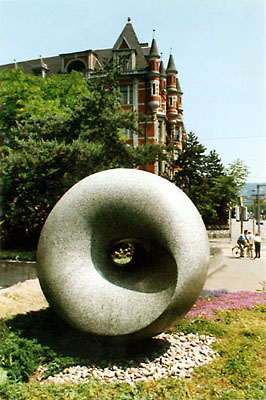
Unit of Sphere and Endless Spiral
-
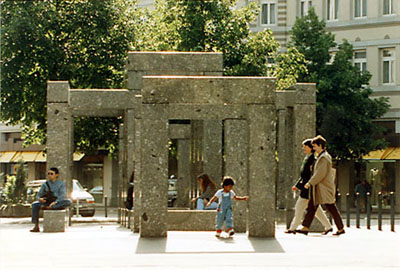
Pavillion Sculpture
-
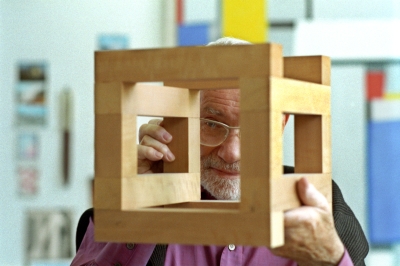
At his studio
-
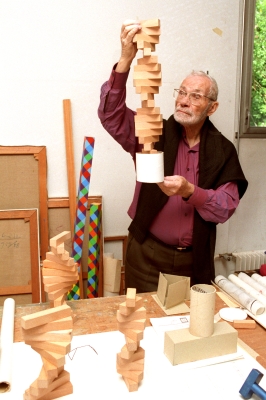
At his studio

